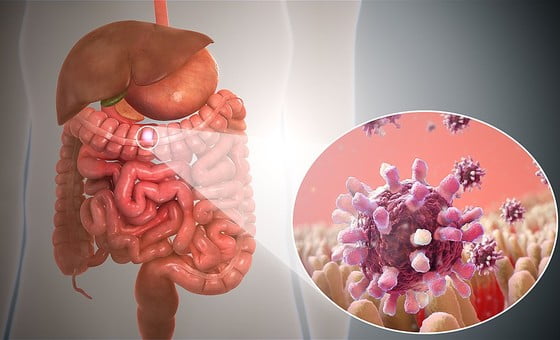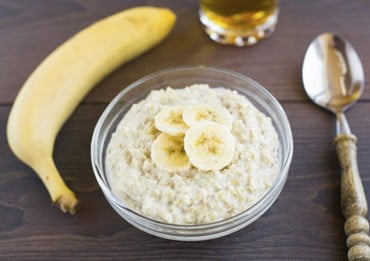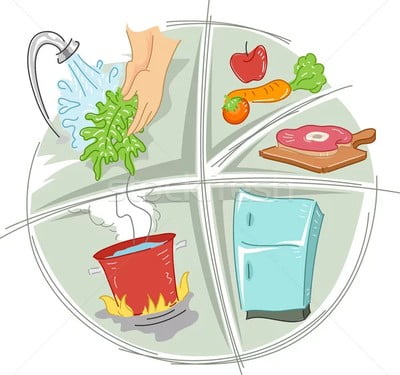What is food poisoning?
Food poisoning (also known as food-borne illness) occurs when you eat or drink something that contains harmful germs (bacteria, viruses, or parasites). Bacteria produce a toxin in food. It’s this toxin that causes the problem.
Symptoms of food poisoning can begin hours or days after consuming contaminated food or drink. The timing depends in part on the cause of the food poisoning. It can also depend on the amount of food or drink you consumed. Symptoms may include:
- abdominal pain
- diarrhea
- fever
- loss of appetite
- nausea
- vomiting
- weakness and fatigue

Food poisoning may affect just one person or a whole group of people who are exposed to the contaminated food or drink. It depends on how much of the germ or toxin each person consumed. It also depends on how sensitive they are to the germ or toxin.
What are the symptoms of food poisoning from fish?
There are two types of food poisoning you can get from eating fish. They are ciguatera poisoning and scombroid poisoning.
Ciguatera poisoning symptoms include abdominal cramps, nausea, vomiting, and diarrhea. Symptoms can progress to headache, muscle aches, and itchy, tingly, or numbness of the skin. You may notice a change in your ability to feel hot or cold temperatures. You may think something feels hot when it is actually cold.
Scombroid poisoning symptoms develop 20 to 30 minutes after you eat the affected fish. They include flushing (turning red) of the face, nausea, vomiting, hives, and abdominal pain. These symptoms are similar to other allergic reactions. Getting scombroid poisoning does not mean you are allergic to fish.
Vibrio vulnificus infection is a bacterial infection to warm, seawater fish. It’s found in shellfish (especially oysters), other seafood, or the ocean. You can get it by eating contaminated fish. You can get it from contact with a fish or the ocean (through an open cut).It is not common and not contagious. The symptoms are similar: fever, vomiting, diarrhea, and abdominal pain. More serious symptoms include a high fever, chills, low blood pressure, redness, swelling, and blisters on your skin. If the bacteria enters an open cut, it can become a more serious infection. Once that happens, it can spread through your bloodstream and become life-threatening. Blood and stool tests lead to a diagnosis. Your doctor also may look at the blisters on your skin.
You can reduce your risk of exposure by not eating undercooked shellfish and other seafood. Wash kitchen utensils in hot, soapy water. Wear gloves when handling the fish if you have an open cut. Avoid ocean water until your cut or wound has healed.
Antibiotics are used to treat the infection. In severe cases, you may need surgery or amputation where a cut or wound was infected with the bacteria.
What causes food poisoning?
Many foods can cause food poisoning. Foods that should be kept cool but aren’t are some of the primary causes of food poisoning. That is why food poisoning is more common at picnics and buffets. There, food (such as the mayonnaise in potato salad) is often left out of the refrigerator for a long time.
Other common sources of food poisoning include:
- raw or undercooked meat or poultry
- unpasteurized dairy products
- raw shellfish
- unwashed fruits
- unwashed vegetables.
How is food poisoning diagnosed?
Many cases of food poisoning never get an official diagnosis. This is because most people recover within a few days at home. If you have severe symptoms of food poisoning, you doctor will diagnose you. He or she may order a blood test to determine if the food poisoning is caused by bacteria. Or, he or she may collect a stool sample to find out what germ is causing the food poisoning.
Can food poisoning be prevented or avoided?
The best way to prevent food poisoning is to always know what you are eating. The best way to always know what you are eating is to eat at home. You can better control food storage and preparation at home. When dining out, be cautious of buffets.
Tips for avoiding food poisoning
You can take a few simple steps to avoid food poisoning:
- Wash fruits and vegetables thoroughly.
- Clean countertops, cutting boards, knives, and utensils before exposing them to different food items.
- Wash your hands and utensils often.
- Don’t put raw and cooked meats on the same plate.
- If knives have been used to cut up uncooked chicken, do not use them to cut up other ingredients that will not be cooked.
- Cook meat thoroughly. Use a meat thermometer if needed. Make sure beef is cooked to at least 160°F, chicken and other poultry to 180°F, and fish to 140°F.
- Don’t use packaged food that has expired.
- Throw away food in bulging or dented cans.
- Refrigerate leftover food if it isn’t going to be eaten within 4 hours.
- Don’t eat wild mushrooms.
- Don’t eat soft cheeses (especially imported) if you are pregnant or have a weak immune system.
- When traveling abroad, don’t eat raw fruits or vegetables that haven’t been washed in an antimicrobial rinse. Avoid unfiltered (or unboiled) tap water.
- When at restaurants or social gatherings, avoid foods that have been left out of the refrigerator for long periods of time.
How can I avoid food poisoning from fish?
To avoid ciguatera poisoning, don’t eat the fish that commonly carry the poison. This includes amberjack, grouper, snapper, sturgeon, king mackerel, barracuda, and moray eel. The poison is more concentrated in a fish’s internal organs, so you should never eat those parts of a fish.
To avoid scombroid poisoning, don’t eat any fish that has not been refrigerated properly. Be especially careful when you eat fish such as tuna, sardines, mackerel, mahi-mahi, or anchovies.
Food poisoning treatment
Most cases of food poisoning are mild and clear up in a few days. During that time, the goal is to prevent dehydration. Dehydration is the loss of fluids and electrolytes (nutrients and minerals) your body needs. You should avoid solid foods and dairy products until the vomiting and diarrhea have passed. Once you are feeling better, ease into eating and drinking again. Try bland foods, such as crackers, toast, and bananas. Avoid spicy foods, fried foods, dairy, and foods that are high in fat and sugar. Drink plenty of fluids, but avoid milk or caffeinated beverages. Also, sports drinks (brand name: Gatorade, others) are not meant to be used to treat diarrhea. They do not replace the body’s electrolytes (salts and minerals) correctly to prevent dehydration.
When should I go to a doctor?
Make an appointment with your doctor if:
- Severe diarrhea lasts for more than 3 days.
- Frequent vomiting lasts for more than 2 days.
- You see blood in your stool.
- You are on diuretics and have diarrhea, nausea or vomiting.
- You have a fever over 101°F.
Seek emergency care if:
- Your stool is maroon or black or you see a lot of blood in your stool.
- You are vomiting blood.
- You are having trouble breathing.
- You have severe abdominal pain or stomach cramping.
- You have double vision or trouble moving parts of your body.
- You have symptoms of severe dehydration (see the list below).
- You have trouble swallowing.
- You feel like your heart is pounding.
- You have food poisoning from eating mushrooms or shellfish.
How is food poisoning from fish treated?
Ciguatera poisoning is treated with medicines that help ease your symptoms. There is no medicine that will cure ciguatera poisoning. The symptoms will go away on their own over time. Scombroid poisoning is treated using an antihistamine (one brand name: Benadryl). An antihistamine is a medicine that blocks the histamine in your blood.
How long will I be sick?
Ciguatera poisoning is treated with medicines that help ease your symptoms. There is no medicine that will cure ciguatera poisoning. The symptoms will go away on their own over time. Scombroid poisoning is treated using an antihistamine (one brand name: Benadryl). An antihistamine is a medicine that blocks the hiThe symptoms of ciguatera poisoning can last for 1 to 2 weeks. Exactly how long they last will depend on the amount of poison you have in your body. The symptoms can come back any time you eat an affected fish. The symptoms of scombroid poisoning usually last for 24 hours or less. The symptoms can come back any time you eat fish that has not been refrigerated properly. Ciguatera and scombroid poisoning are rarely fatal.stamine in your blood.
How do I know if I’m dehydrated?
Symptoms of dehydration include:
Extreme thirst
Sleepiness or fatigue
Feeling dizzy or lightheaded
Confusion
Headache
Little, darker or no urine
Dry mouth
Not elastic skin
- little or no urine, or urine that is darker than usual;
- dry mouth;
- sleepiness or fatigue;
- extreme thirst;
- headache;
- confusion;
- feeling dizzy or lightheaded;
- no tears when crying.
To treat mild dehydration, try taking frequent sips of water. Clear soups, clear sodas, and juice mixed with water can also help. Avoid coffee, tea, dark sodas, and other caffeinated drinks. These drinks can make dehydration worse. Give children who have mild dehydration water and/or an oral rehydration solution (ORS). An ORS contains the right mix of salt, sugar, potassium, and other nutrients to help replace lost body fluids. You can buy an ORS at most grocery stores and drugstores. If your dehydration is severe, you may need to be treated in the hospital. There, doctors will give you intravenous (through an IV) fluids and electrolytes.
Is food poisoning a serious condition?
It can be. Dehydration can be dangerous, and so can certain types of food poisoning. Food poisoning caused by the Listeria bacteria can be very dangerous for the unborn babies of pregnant women. The infection is usually very mild for the mother, but can cause miscarriage, premature labor, stillbirth and developmental problems in their babies. People who have weakened immune systems are also at risk of developing complications from Listeria. Food poisoning caused by Escherichia coli (E. coli) bacteria can cause hemolytic uremic syndrome (HUS). HUS can cause kidney failure, especially in people who have weakened immune systems.
Living with food poisoning
Food poisoning is a condition that comes and goes. However, you can be more likely to get food poisoning than other people.
Children and the elderly are most likely to get food poisoning. You may also be at a higher risk if you:
- Have a chronic medical condition, such as kidney diseaseor diabetes.
- Are pregnant.
- Have recently traveled to areas outside the United States. You may have had greater exposure to germs that can cause food poisoning.
- Have a weakened immune system. This could be caused by drugs taken after an organ transplant, certain chemotherapy medicines, or infection with the human immunodeficiency virus (HIV).

Questions to ask your doctor
- How do I know my symptoms are caused by food poisoning?
- Are there medicines that prevent food poisoning?
- Is food poisoning dangerous? When should I call you?
- How is food poisoning different from other digestive disorders?
- How long will it take me to recover from food poisoning?
- Do I have a food allergy?
- How long will I feel sick with a Vibrio vulnificus infection?
- I have kidney disease. Should I avoid eating shellfish?
